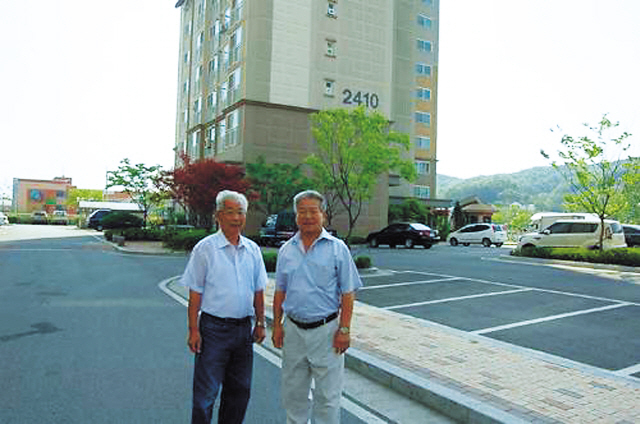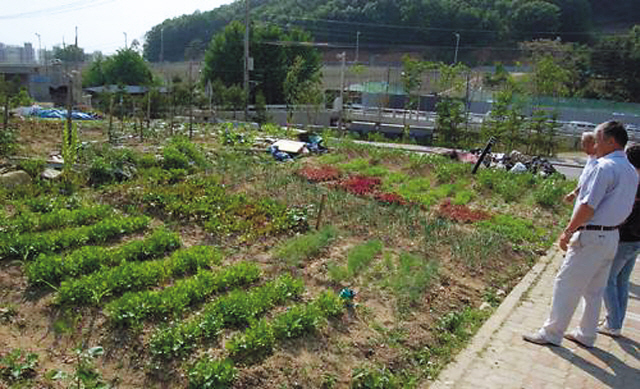In Namyangju, a suburb just northeast of Seoul, a community has formed of mostly elderly people whose lives reflect Korea’s turbulent history over the past century.
Sakhalin Koreans, as they are known, have found a permanent home after an ordeal that has stretched over decades and outlasted both World War II and the Cold War. They were taken by Japan, Korea’s colonial ruler at the time, during the war years to the icy island east of the Russian mainland as laborers, and abandoned there as stateless people. It was the beginning of a saga that still hasn’t reached an amiable conclusion.
The complex in Namyangju is home to about 30 households of Sakhalin Koreans. They live two to a unit, either married couples or two single men or women cohabitating.
“There is lots for us to do,” said Lee Jeong-hee, a woman with bouffant hair and heavy eye makeup. “We play tennis, sing, read books, take English classes.”
Government estimates say there were roughly 43,000 Koreans on Sakhalin when World War II ended with Japan’s surrender. Now, the first-generation Koreans there are estimated at around 1,500, others having passed away.
Some Koreans went to Sakhalin to seek well-paid work in mines.
When the Sino-Japanese War broke out in 1937, Japan needed laborers to work in weapons manufacturing. Sakhalin at the time was, like Korea, a part of the Japanese empire. The Japanese began to officially draft Koreans to Sakhalin as laborers. This year is the 75th anniversary of the drafting of those Koreans.
After Japan’s 1945 surrender in World War II, the Soviet Union recovered control of Sakhalin. There was still a shortage of labor on the island and the stateless Koreans were prevented from leaving. South Korea never established diplomatic relations with the Soviet Union, which left the Koreans with no diplomatic assistance and no way home.
Despite efforts at accommodation made by the Soviet administration, many Sakhalin Koreans maintained loyalty to South Korea and unsuccessfully sought repatriation. After the collapse of the Soviet Union in 1989, South Korea normalized ties with Russia the following year and negotiated the repatriation of the first generation of Sakhalin Koreans.
Many of the Sakhalin Koreans who came to Korea live scattered in clusters in the suburbs that surround Seoul. With government support, they manage to live in peace, with one serious exception: many had to leave their children behind when they came.
Government relocation assistance was provided only to Sakhalin Koreans born before independence in 1945.
Sakhalin Koreans, as they are known, have found a permanent home after an ordeal that has stretched over decades and outlasted both World War II and the Cold War. They were taken by Japan, Korea’s colonial ruler at the time, during the war years to the icy island east of the Russian mainland as laborers, and abandoned there as stateless people. It was the beginning of a saga that still hasn’t reached an amiable conclusion.
The complex in Namyangju is home to about 30 households of Sakhalin Koreans. They live two to a unit, either married couples or two single men or women cohabitating.
“There is lots for us to do,” said Lee Jeong-hee, a woman with bouffant hair and heavy eye makeup. “We play tennis, sing, read books, take English classes.”
Government estimates say there were roughly 43,000 Koreans on Sakhalin when World War II ended with Japan’s surrender. Now, the first-generation Koreans there are estimated at around 1,500, others having passed away.
Some Koreans went to Sakhalin to seek well-paid work in mines.
When the Sino-Japanese War broke out in 1937, Japan needed laborers to work in weapons manufacturing. Sakhalin at the time was, like Korea, a part of the Japanese empire. The Japanese began to officially draft Koreans to Sakhalin as laborers. This year is the 75th anniversary of the drafting of those Koreans.
After Japan’s 1945 surrender in World War II, the Soviet Union recovered control of Sakhalin. There was still a shortage of labor on the island and the stateless Koreans were prevented from leaving. South Korea never established diplomatic relations with the Soviet Union, which left the Koreans with no diplomatic assistance and no way home.
Despite efforts at accommodation made by the Soviet administration, many Sakhalin Koreans maintained loyalty to South Korea and unsuccessfully sought repatriation. After the collapse of the Soviet Union in 1989, South Korea normalized ties with Russia the following year and negotiated the repatriation of the first generation of Sakhalin Koreans.
Many of the Sakhalin Koreans who came to Korea live scattered in clusters in the suburbs that surround Seoul. With government support, they manage to live in peace, with one serious exception: many had to leave their children behind when they came.
Government relocation assistance was provided only to Sakhalin Koreans born before independence in 1945.

“Our situation is symbolic of how the Korean people are divided,” said Baek Ha-deuk, 66, a Sakhalin Korean resident of Namyangju.
Lee Su-jin, an honorary chairman of the Korea Sakhalin Family Reunion Association, was born in Sakhalin. He lived there until moving to South Korea in 2002. “Life is more comfortable here,” Lee said.
They must live frugally. Each pair receives a basic livelihood allowance of 700,000 to 800,000 Korean won (about $595-680). A monthly rent of 150,000 won is subtracted from that. Their monthly stipend has been static since 2000 despite steep rises in the prices of food and energy.
And in their land of ethnic ancestry, they have not totally escaped the discrimination they experienced in Sakhalin. The Sakhalin Koreans say the other residents of their complex prefer not to associate with them, so they stick together to keep each other company.

“The Sakhalin Koreans living in South Korea are mostly in their 90s. They are approaching the end of their lives,” said Bae Deok-ho, the president of the Korean International Network, a non-profit organization that works in the interests of Koreans living abroad. Of some 4,000 Sakhalin Koreans who returned to South Korea, about 1,000 have passed away.
For older ethnic Koreans with children who remain on Sakhalin, a major concern is loosening cultural ties among the younger generation. “Our biggest worry is that the younger generation will lose their cultural identity as Koreans. The young people nowadays can’t speak Korean well and they don’t know the culture,” Lee said.
Part of the reason is that it isn’t easy for young Sakhalin Koreans to make a life in South Korea. They are only eligible for 5-year visas and to even apply for those, they need to have graduated from a university.
These difficulties are among the reasons many young people would rather stay in Sakhalin. To them, South Korea is the land of their ancestors. Sakhalin is home to them and Russian is their first language.
For those who do want to come to Korea, the cost is higher than they can afford.
South Korea’s 18th National Assembly ended on April 24 without the passage of a bill that would have provided state funds for the repatriation of Koreans still on Sakhalin who wish to relocate. The bill had been under consideration since the 16th National Assembly, a running time of about 10 years.
“No one knows exactly how much it would cost to move everyone here. The only calculations have been made by our organization,” said Bae. “The government hasn’t looked into the actual costs.”
The Sakhalin Koreans already here can’t wait much longer to be reunited with their children. Many are elderly and don’t have descendents in Korea or the funds for a proper funeral. When they pass away, their bodies are cremated. Since they can’t pay for space in a charnel house, their ashes are sprinkled into the ocean, where they dissolve into the same waters they rode over on their way to Sakhalin, 75 years ago. (Yonhap News)
-
Articles by Korea Herald








![[Graphic News] More Koreans say they plan long-distance trips this year](http://res.heraldm.com/phpwas/restmb_idxmake.php?idx=644&simg=/content/image/2024/04/17/20240417050828_0.gif&u=)
![[KH Explains] Hyundai's full hybrid edge to pay off amid slow transition to pure EVs](http://res.heraldm.com/phpwas/restmb_idxmake.php?idx=644&simg=/content/image/2024/04/18/20240418050645_0.jpg&u=20240419100350)






![[From the Scene] Monks, Buddhists hail return of remains of Buddhas](http://res.heraldm.com/phpwas/restmb_idxmake.php?idx=652&simg=/content/image/2024/04/19/20240419050617_0.jpg&u=20240419175937)

![[KH Explains] Hyundai's full hybrid edge to pay off amid slow transition to pure EVs](http://res.heraldm.com/phpwas/restmb_idxmake.php?idx=652&simg=/content/image/2024/04/18/20240418050645_0.jpg&u=20240419100350)

![[Today’s K-pop] Illit drops debut single remix](http://res.heraldm.com/phpwas/restmb_idxmake.php?idx=642&simg=/content/image/2024/04/19/20240419050612_0.jpg&u=)